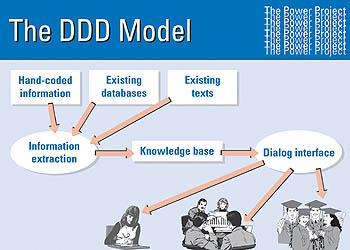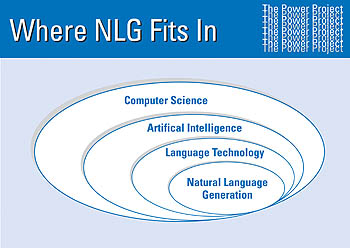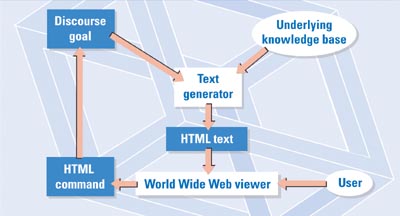|
The Power project was a joint project run by the Centre
for Language Technology (CLT) at Macquarie University
and CSIRO’s Intelligent
Interactive Technology Group.
The
goal of the project was to:
design
software that would let people call up information
from databases to fit their needs, taking account
of — how much they already know about the topic
and had learned so far — and even the language
they speak. The information the system provided would
not have been previously composed by an author but
generated automatically by the system.
The
system takes information stored in a database, and uses
natural language generation techniques, to automatically
generate online hypertext documents for the user to
read. This is dynamic
document delivery (DDD).

The Dynamic Document Delivery model |
As
part of this project, the research team worked with
the Powerhouse Museum, Sydney to develop the Power
system. The intent was to use information from
the Museum’s database to create a new system to
dynamically generate web pages describing and comparing
objects in the Museum’s collection.

The
Power project - click on image to view a larger image. |
Natural
language
Once the system has selected the information it will
present, and organised that information into the structure
of a coherent text, it then needs to be able to turn
that information into natural language. This means it
needs to turn the structured information into a web
page that you can just read like any other page on the
Internet. Hence, the system needs to be able to generate
ordinary language. To do this it needs a lexicon (or
dictionary) of all the words and parts of words it needs,
along with a grammar that it can use to put these building
blocks together to make sentences. The system needs
to be able to do something similar to what we do each
time we construct a sentence when we are speaking.
But
it’s not enough to just generate web pages in
natural language. Normally if you move from one page
to another, information is presented each time as if
you are reading it for the first time. But one of the
goals of the Power project was to make the
system remember what you have already looked at and
present the information in a way that follows on from
that. For example you might look at a description of
a pair of shoes which partly says “these shoes
are made of patent leather and have laces”. Then
if you go on to a comparison of the shoes and a pair
of boots, it needs to remember that you’ve just
read about the shoes. Instead of then saying “this
pair of shoes and this pair of boots are both made of
patent leather and both have laces” it might say
“like the shoes, the boots are made of patent
leather and have laces”. This way the pages make
more sense and are easier to read as you move from one
page to the next. This is called discourse
coherence. Taking this
idea of context-sensitive generation even further, the
Power system was designed so you can enter user information
about yourself and it will remember who you are and
tailor the descriptions it gives you to what you already
know.

Natural language generation |
Language
generation applications
Language generation can be used for:
- Multilinguality: multiple output languages from
one source representation.
- Customised information delivery: gives the user
information tuned to what the system knows about them.
- Dialogue: the system’s output takes account
of the previous conversational context.
- Self-generating documentation: removes need
to keep data and documents in step.
Different
languages
The actual language that the pages are generated in
is also an issue. One of the main goals of the Power project was to design a system that would generate texts
that would be tailored to suit each user‘s need.
Part of this involved designing a system that could
dynamically generate texts in different languages, so
if you spoke French instead of English, for example,
the system could generate a text in French so you could
read it. The natural language generation part of the
system had to work for other languages.

A page from the Power project in French |
The
system the Power project set out to design had to be
able to select data from a database, structure the text
that it was going to generate, then turn that into natural
language. And it needed to be able to do this in a very
flexible and interactive way.
To
make all this work, the team needed to design system
architecture to combine the components of the system
and integrate the user’s input.
Activity
Often the output from a database is in tabular form.
How would you deliver the following information as natural
language?
Functions
and sources of minerals
| Mineral |
Function |
Food source |
| Chromium |
Role in carbohydrate metabolism |
Meat, cheese, legumes |
| Selenium |
Component of antioxidant enzyme |
Seafood, meat, cereals |
System
architecture
The key to making any system work is the system architecture.
This is basically the structure that all the components
of the system fit into, and the connections between
the components that let them work together to do the
job the system is designed to do.
The
Power system had components that:
- selected information from a database
- structured this information into a text plan
- turned the text plan into natural language.
The
Power project developed new ways of making these components
function. The traditional Natural Language Generation architecture, however, is one way of making these
components work together.
The
standard Natural language generation architecture picks
information from a database (the knowledge base) on
the basis of the reason the text is being generated
(the discourse goals). It structures this information
into a text plan, then generates a surface realisation,
in other words a document in natural language.
The
problem with this architecture was that it was not interactive
enough for what the Power project wanted to achieve.
It could not take into account the other web pages the
user had just looked at and all the other issues that
would make the system flexible enough to be able to
tailor each page exactly to the user’s needs.
To
make the system that interactive the Power team developed
a system architecture called Dynamic Hypertext.
On
the left you can see a traditional natural language
generation architecture and on the right the dynamic
hypertext architecture.

Natural language architecture Dynamic hypertext architecture |
Dynamic
hypertext architecture
Most of this architecture looks like the traditional
natural language generation architecture. The big difference
is that the end result of the language generation part
of the system is not just a document in natural language.
Instead it is an HTML document that can be viewed
on the World Wide Web. The web page the user looks at
to view the document also contains an html command capability
that lets the user send instructions back to the beginning
of the document generation process. It also lets the
system remember what pages the user has looked at, and
gather other information on the user so it can create
documents tailored to the user’s needs.
The
traditional architecture is basically a one way process.
You can ask the system for a document, and it can generate
it. The dynamic hypertext architecture, on the other
hand instead, is an interactive loop that constantly
generates documents in response to the user’s
use of the system. It’s a two way process, so
it’s a much more flexible and effective structure
for presenting the information the user needs.
A
simpler version of the previous diagram can be seen
below.

DDD architecture |
To
find out more about dynamic hypertext and the Power system architecture click here.
The
Centre for Language Technology
The Centre for Language Technology started life in 1994 as the Natural Language Processing
Unit in the Microsoft Research Institute for Advanced
Software Technology at Microsoft Australia. Later the
unit moved to the Department of Computing at Macquarie
University and became the Language Technology Group
(LTG). CSIRO became a sponsor of the LTG (and later
the Centre for Language Technology), and Cécile
Paris and her team are actively in collaboration with
the researchers in LTG at Macquarie.
In
2001 LTG was expanded and became the Centre for Language
Technology (CLT) as part of Macquarie University’s
Division of Information and Communication Sciences.
CLT’s
main job is to develop new technology to allow computers
to use human language. This research aims to get computers to use the same kind of language
that people use and to make it easier for people to
interact with them computers directly.
Activity
Develop a screen design for the Power project.
|